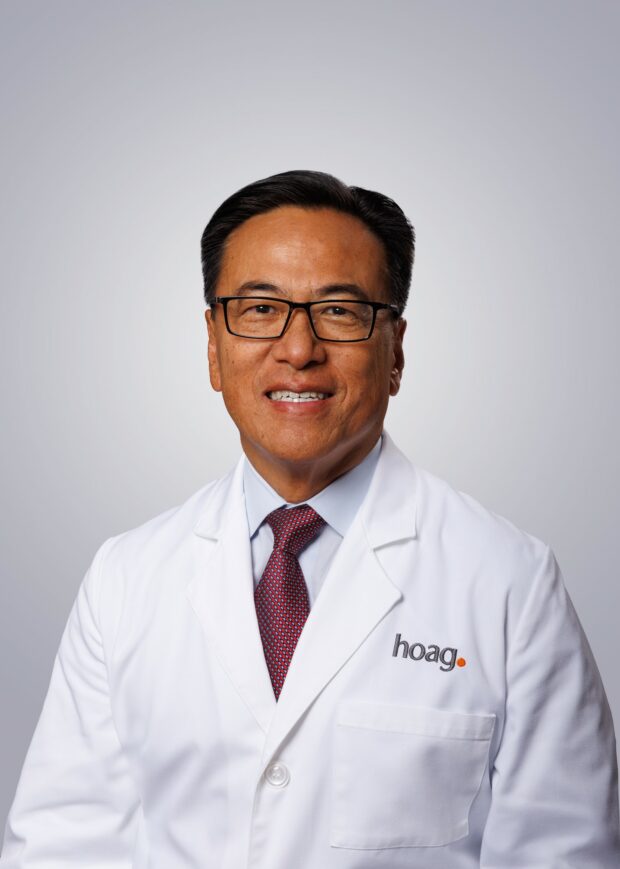
Editor’s Note: Dr. Kenneth Chang is the James & Pamela Muzzy executive medical director endowed chair in GI Cancer at the Hoag Digestive Health Institute. Dr. Chang was previously at the University of California, Irvine, where he practiced for 30 years and built UCI’s Comprehensive Digestive Disease Center and Digestive Health Institute.
He’s published more than 480 scientific articles, abstracts, book chapters and textbooks, as well as training and mentoring over 50 national and international advanced fellows who are now leaders in their respective regions. He considers acid reflux (GERD), obesity and diabetes as pre-cancerous conditions – hence his efforts to treat these conditions using novel endoscopic approaches.
Dr. Chang has developed numerous devices that have touched the lives of patients globally, including the Endoscopic Radio-frequency Ablation (RFA) for the treatment of Barrett’s Esophagus, which bears the name “Chang Cap” due to his contributions — it is the world’s most popular device for treating and curing Barrett’s.
When people think of risk factors associated with deadly cancer, gastrointestinal esophageal reflux disease (GERD) is not the first condition that comes to mind. After all, GERD is a common condition, one that is generally chalked up to spicy food and treated with over-the-counter medications.
But left to flourish, GERD can develop into Barrett’s esophagus, the precursor to esophageal cancer. Unfortunately, that transformation occurs all too often. Cancer rates for nearly every type of cancer are on a downward trend. Between 2000 and 2021 the rate of new cancer cases per 100,000 people declined by 5.7%, while the annual mortality rate fell by 28%.
Meanwhile, the rate of esophageal cancer, and of esophageal cancer death, increased by 10-fold between 1973–2011, according to a national database. This makes something that is typically thought of as a nuisance—heartburn—potentially more insidious. The evolution from chronic heartburn and acid reflux to precancerous Barrett’s is silent. By the time a patient has trouble swallowing, it is likely too late.
New Tech to Address This Disease
The good news is that we have the skill and technology to address this disease, if it is caught early. There was a time when treatment for Barrett’s esophagus meant removing the esophagus. I liken this extremely invasive treatment to demolishing your house just to re-wallpaper the bathroom.
Technologies that I helped pioneer over the last several decades can target just the precancerous cells and encourage healthy cells to regrow.
Using a scope and a camera, we can remove diseased portions of the esophageal lining in a procedure called endoscopic mucosal resection (EMR), or more commonly, we can use endoscopic radiofrequency ablation (RFA) to eradicate precancerous cells. RFA was pioneered right here in Orange County, with the most commonly used device worldwide bearing the name “Chang Cap.” It is highly effective, and it can essentially give the patient back a normal esophagus without surgery or cutting.
The need to eradicate the precursor to esophageal cancer in a more palatable way has now been met. And yet, the rates of esophageal cancer continue to rise—as does the morbidity of the disease. Clearly, the new unmet need is education and easily accessible risk stratification.
Specifically, we must create a program where public awareness and an electronic medical record, which automatically identifies people who are at risk for esophageal cancer, prompts them to get a simple screening test. The test would categorize individuals into two “buckets,” those who may have Barrett’s or cancer vs those who don’t have either. Those who are deemed at risk can then move on to get a screening endoscopy, possibly including biopsies, for a proper diagnosis.
Non-Invasive Screen Device
At Hoag, we are uniquely positioned to launch such a program. My colleague Phoenix Nguyen, M.D., a nationally recognized therapeutic endoscopist and medical director of the Hoag Advanced Endoscopy Center, is spearheading the implementation of a non-invasive screening device called EsoGuard. This ingenious device requires a person to swallow a capsule that is tethered to a string-like tube, which then inflates a balloon in the lower esophagus to collect cells for analysis—looking for potential DNA changes associated with Barrett’s esophagus. No sedation is necessary, and it takes 3-5 minutes.
Our hope is to widen the top of the funnel by potentially identifying all patients at risk for esophageal cancer using an easy and accessible screening test.
We are now working with primary care physicians in the community to get the word out to recommend this 5-minute test on everyone who fits the high-risk profile, including: a family history of esophageal cancer or Barrett’s esophagus, heavy smokers, male, White, over 50, obesity and acid reflux. After collecting cells, we will test them for genetic biomarkers that indicate whether a person is at increased risk. For those who are not at risk, we give them peace of mind. For those with Barrett’s esophagus, we can perform resection and/or ablation for those deemed high risk for cancer, otherwise all Barrett’s patients will be offered a surveillance program that monitors their health over time.
This will allow us to meet that huge unmet need of uncovering the precursor to esophageal cancer before it has time to develop. Using innovation and a comprehensive program, we can achieve an esophageal cancer-free Orange County.
It may be surprising that a deadly cancer can start with GERD. It is my hope that GERD is where it ends.
